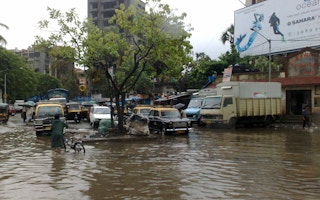India has seen millions of people fleeing failing agriculture to megacities that are poorly equipped to handle the influx amid increased threats from climate hazards particularly floods and heat waves, say researchers.
Climate change that affects agriculture is driving migrants to relocate to urban areas like New Delhi and Mumbai in search of better living conditions and alternative livelihoods, according to a study published 19 July in Nature Climate Change.
“Although migration is perceived as an important adaptation mechanism to counteract the negative outcomes of climate change, climate extremes at the destination location can have a detrimental effect on migrants,” says Vittal Hari, an author of the study and researcher at UFZ–Helmholtz Centre for Environmental Research, in Leipzig, Germany.
According to Vittal, the study highlights how the emergence of two fundamentally different but equally devastating hazards — heatwaves and floods — can contribute to the vulnerability of migrants at their destination.
In South Asia, deadly heatwaves are projected to increase in the future as a result of climate change. “As increasing heat in urban areas is intrinsically linked to population growth, we envisage that a large influx of migrants will further amplify the effect of heatwaves in the already densely populated megacities,” the study said.
Between 1978 and 2014, India suffered more than 660 heat waves – defined as temperatures above the normal average and lasting two days or more – that caused the deaths of 12,273 people, according to a study published in June.
“
We need to acknowledge that migration is happening and prepare for it in a better manner — by increasing coping and adaptation capacities of people while also focusing on mitigating climate change.
Rohini Kumar, researcher, UFZ-Helmholtz Centre for Environmental Research
The worst effects of heatwaves will be felt by the migrant community who often end up living in closely packed dwellings with basic amenities missing and air conditioning far beyond their reach. This is particularly true of Delhi where deaths from heatwaves have been on the rise.
Coastal cities such as Mumbai face a different kind of hazard — flooding caused by tropical cyclones and sea-level rise. “A substantial rise in the pre-monsoon sea-surface temperature, specifically in the Arabian Sea, creates a conducive environment for the genesis and propagation of tropical cyclones,” the authors said.
Flooding in these cities would likely pose major difficulties for both short-term emergency management and the longer-term recovery of migrant communities, who generally live in low-elevation areas, the study added. In Mumbai, where the influx of marginal migrants (those with meagre resources) is very high, such events often result in huge monetary losses.
“Overall, there is a pressing need for robust policy frameworks to protect these marginal migrants from contemporary and future climatic hazards,” Vittal tells SciDev.Net.
According to the study, a large majority of the migrants are from Uttar Pradesh and Bihar — northern states in the intensively cropped Indo-Gangetic plains and home to 640 million people living in poverty. Outmigration from the area is both seasonal and permanent, revealing systemic instability in the agricultural sector, the study said.
Rohini Kumar, study co-author and researcher at UFZ, says the reverse migration due to Covid-19 lockdowns, from cities to rural areas, highlighted the devastation that external disturbances can bring about. “The issue of climate-related extremes and consequent and cascading aftermath remains real — the risk is not apparent just during the Covid-19 lockdowns but exists in both long- and short-term and is expected to affect everyone.”
Greater attention is needed to take care of vulnerable new migrants, who lack necessary resources, when designing adaptation and mitigation policies, says Kumar.
“We need to acknowledge that migration is happening and prepare for it in a better manner — by increasing coping and adaptation capacities of people while also focusing on mitigating climate change,” he adds. “We may also need to strengthen existing policies to ensure that they are inclusive of the marginal migrant population.”
Swati Singh Sambyal, an independent resource management and circular economy expert, says that it is important for city planners to recognise the crisis of climate migration and have implementable plans and strategies for better liveability, social security and healthcare for migrants.
“None of these existed which is why the migrant workers fled the cities on lockdown,” says Sambyal.
This article was originally published on SciDev.Net. Read the original article.










